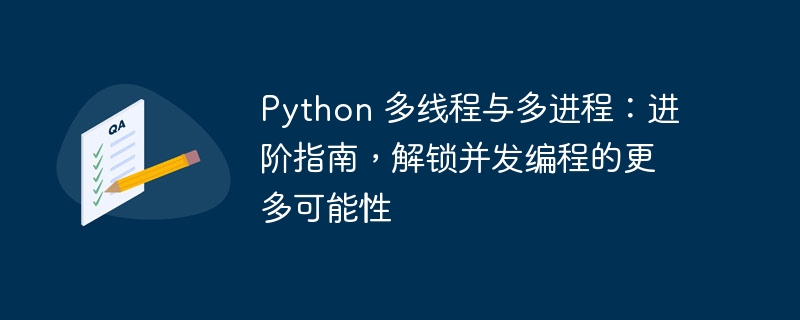Home >Backend Development >Python Tutorial >Python multithreading and multiprocessing: an advanced guide to unlock more possibilities for concurrent programming
Python multithreading and multiprocessing: an advanced guide to unlock more possibilities for concurrent programming
- WBOYWBOYWBOYWBOYWBOYWBOYWBOYWBOYWBOYWBOYWBOYWBOYWBforward
- 2024-02-25 09:16:24624browse

1. Basic concepts of Python multi-threading and multi-process
Multi-threading and multi-process are two different Concurrent programming technologies. Multi-threading refers to executing multiple tasks simultaneously in one process, while Multi-process refers to executing multiple tasks simultaneously in different processes.
The advantage of multi-threading is that the switching cost between threads is very low, and the same memory space can be shared, so the communication overhead is very small. However, multi-threading also has some disadvantages, such as synchronization and communication between threads are more difficult, and multi-threaded programs are more prone to deadlock problems.
Multi-processThe advantage is that the isolation between processes is relatively good, and the advantages of multi-core processors can be fully utilized. However, the disadvantage of multi-process is that the cost of switching between processes is relatively high, and the communication overhead between processes is relatively large.
2. Python multi-threading and multi-process implementationIn
python, multi-threading and multi-process programming can be achieved by using the threading and multiprocessing modules.
2.1 Multi-threaded programming
import threading
def task1():
print("Task 1 is running...")
def task2():
print("Task 2 is running...")
if __name__ == "__main__":
t1 = threading.Thread(target=task1)
t2 = threading.Thread(target=task2)
t1.start()
t2.start()
t1.join()
t2.join()
In this example, we define two thread tasks, then use the
class to create two thread objects, and use the task function as the target function of the thread object. Finally, we use the start() method to start the thread and use the join() method to wait for the thread to end.
2.2 Multi-process programming
import multiprocessing
def task1():
print("Task 1 is running...")
def task2():
print("Task 2 is running...")
if __name__ == "__main__":
p1 = multiprocessing.Process(target=task1)
p2 = multiprocessing.Process(target=task2)
p1.start()
p2.start()
p1.join()
p2.join()
In this example, we define two process tasks, then use the
class to create two process objects, and use the task function as the target function of the process object. Finally, we use the start() method to start the process and use the join() method to wait for the process to end.
3. Python multi-threading and multi-process application scenariosMulti-threading and multi-process programming have a wide range of application scenarios in actual
development. Some common application scenarios include:
- Multi-core processing:
- Make full use of the advantages of multi-core processors to improve program execution efficiency. Network programming:
- Process a large number of network requests and improve the concurrency processing capability of the server. Data processing:
- Process large amounts of data in parallel to shorten data processing time. Scientific computing:
- Execute complex computing tasks in parallel to improve computing efficiency.
When using
Pythonmulti-threaded and multi-process programming, you may encounter some common problems. Some of the common problems include:
- Deadlock:
- In a multi-threaded or multi-process program, if threads or processes wait for each other, causing the program to be unable to continue executing, this situation is called a deadlock. Data race:
- When multiple threads or processes access shared data at the same time, data race problems may occur, causing the program to produce incorrect results. Resource leakage:
- When a thread or process is not destroyed correctly after being created, it may cause resource leakage problems, causing the program to occupy too many system resources.
Python Multi-threading and multi-process are two important concurrent programming technologies, which can make full use of the computer's processing power and improve the execution efficiency of the program. In this article, we deeply explore the principles, usage, and common application scenarios of Python multithreading and multiprocessing, hoping to help you unlock more possibilities for concurrent programming.
The above is the detailed content of Python multithreading and multiprocessing: an advanced guide to unlock more possibilities for concurrent programming. For more information, please follow other related articles on the PHP Chinese website!
Related articles
See more- Front-end performance optimization methods
- Detailed explanation of the neglected performance optimization tool in PHP: generator
- Concurrent programming knowledge points for Java thread learning
- Golang high-concurrency programming practice: using Goroutines to achieve performance optimization
- Multi-core processing: Using Go WaitGroup to implement concurrent computing in Golang

